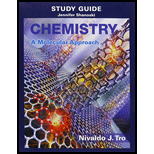
Study Guide for Chemistry: A Molecular Approach
4th Edition
ISBN: 9780134066271
Author: Nivaldo J. Tro
Publisher: PEARSON
expand_more
expand_more
format_list_bulleted
Concept explainers
Question
Chapter 10, Problem 1SAQ
Interpretation Introduction
Interpretation: The molecular geometry of CBr4
Linear
B) Trigonal planner
Tetrahedral
Trigonal pyramidal
Concept Introduction:
Expert Solution & Answer
Answer to Problem 1SAQ
Correct answer:(C)
Explanation of Solution
Reason for correct option:
Lewis structure of

The central atom (C) has four electron groups and all are bonding groups. The electron and molecular geometry of four electron groups is tetrahedral.
Reasons for incorrect options:

The other options doesn't form tetrahedral.
Want to see more full solutions like this?
Subscribe now to access step-by-step solutions to millions of textbook problems written by subject matter experts!
Chapter 10 Solutions
Study Guide for Chemistry: A Molecular Approach
Ch. 10 - Prob. 1SAQCh. 10 - Prob. 2SAQCh. 10 - Prob. 3SAQCh. 10 - Prob. 4SAQCh. 10 - Prob. 5SAQCh. 10 - Prob. 6SAQCh. 10 - Prob. 7SAQCh. 10 - Prob. 8SAQCh. 10 - Prob. 9SAQCh. 10 - Q10. Apply molecular orbital theory to predict...
Ch. 10 - Q11. Apply molecular orbital theory to determine...Ch. 10 - Q12. Which hybridization scheme occurs about...Ch. 10 - Q13. Which molecular geometry results when a...Ch. 10 - Prob. 14SAQCh. 10 - Prob. 15SAQCh. 10 - 1. Why is molecular geometry important? Cite some...Ch. 10 - 2. According to VSEPR theory, what determines the...Ch. 10 - 3. Name and sketch the five basic electron...Ch. 10 - 4. Explain the difference between electron...Ch. 10 - 5. Give the correct electron and molecular...Ch. 10 - 6. How do you apply VSEPR theory to predict the...Ch. 10 - Prob. 7ECh. 10 - Prob. 8ECh. 10 - 9. In valence bond theory, what determines the...Ch. 10 - 10. In valence bond theory, the interaction energy...Ch. 10 - Prob. 11ECh. 10 - Prob. 12ECh. 10 - 13. How is the number of hybrid orbitals related...Ch. 10 - Prob. 14ECh. 10 - Prob. 15ECh. 10 - 16. Name the hybridization scheme that corresponds...Ch. 10 - Prob. 17ECh. 10 - Prob. 18ECh. 10 - 19. What is a bonding molecular orbital?
Ch. 10 - 20. What is an antibonding molecular orbital?
Ch. 10 - 21. What is the role of wave interference in...Ch. 10 - Prob. 22ECh. 10 - 23. How is the number of molecular orbitals...Ch. 10 - 24. Sketch each molecular orbital.
a. σ2s
b.
c....Ch. 10 - Prob. 25ECh. 10 - Prob. 26ECh. 10 - Prob. 27ECh. 10 - Prob. 28ECh. 10 - Prob. 29ECh. 10 - 30. Write a short paragraph describing chemical...Ch. 10 - 31. A molecule with the formula AB3 has a trigonal...Ch. 10 - 32. A molecule with the formula AB3 has a trigonal...Ch. 10 - 33. For each molecular geometry, list the number...Ch. 10 - Prob. 34ECh. 10 - 35. Determine the electron geometry, molecular...Ch. 10 - 36. Determine the electron geometry, molecular...Ch. 10 - 37. Which species has the smaller bond angle, H3O...Ch. 10 - Prob. 38ECh. 10 - 39. Determine the molecular geometry and sketch...Ch. 10 - Prob. 40ECh. 10 - Prob. 41ECh. 10 - Prob. 42ECh. 10 - 43. Each ball-and-stick model shows the electron...Ch. 10 - 44. Each ball-and-stick model shows the electron...Ch. 10 - 45. Determine the geometry about each interior...Ch. 10 - Prob. 46ECh. 10 - Prob. 47ECh. 10 - Prob. 48ECh. 10 - Prob. 49ECh. 10 - Prob. 50ECh. 10 - 51. Determine whether each molecule is polar or...Ch. 10 - Prob. 52ECh. 10 - 53. The valence electron configurations of several...Ch. 10 - 54. The valence electron configurations of several...Ch. 10 - 55. Write orbital diagrams (boxes with arrows in...Ch. 10 - Prob. 56ECh. 10 - 57. Write orbital diagrams (boxes with arrows in...Ch. 10 - Prob. 58ECh. 10 - 59. Which hybridization scheme allows the...Ch. 10 - Prob. 60ECh. 10 - Prob. 61ECh. 10 - 62. Write a hybridization and bonding scheme for...Ch. 10 - Prob. 63ECh. 10 - 64. Write a hybridization and bonding scheme for...Ch. 10 - 65. Write a hybridization and bonding scheme for...Ch. 10 - Prob. 66ECh. 10 - 67. Consider the structure of the amino acid...Ch. 10 - 68. Consider the structure of the amino acid...Ch. 10 - 69. Sketch the bonding molecular orbital that...Ch. 10 - Prob. 70ECh. 10 - 71. Draw an MO energy diagram and predict the bond...Ch. 10 - Prob. 72ECh. 10 - Prob. 73ECh. 10 - Prob. 74ECh. 10 - Prob. 75ECh. 10 - 76. Using the molecular orbital energy ordering...Ch. 10 - 77. Use molecular orbital theory to predict if...Ch. 10 - 78. Use molecular orbital theory to predict if...Ch. 10 - Prob. 79ECh. 10 - Prob. 80ECh. 10 - 81. Draw an MO energy diagram for CO. (Use the...Ch. 10 - Prob. 82ECh. 10 - 83. For each compound, draw the Lewis structure,...Ch. 10 - 84. For each compound, draw the Lewis structure,...Ch. 10 - 85. Amino acids are biological compounds that link...Ch. 10 - 86. The genetic code is based on four different...Ch. 10 - 87. The structure of caffeine, present in coffee...Ch. 10 - 88. The structure of acetylsalicylic acid...Ch. 10 - 89. Most vitamins can be classified as either fat...Ch. 10 - 90. Water does not easily remove grease from...Ch. 10 - Prob. 91ECh. 10 - Prob. 92ECh. 10 - 93. Bromine can form compounds or ions with any...Ch. 10 - 94. The compound C3H4 has two double bonds....Ch. 10 - Prob. 95ECh. 10 - Prob. 96ECh. 10 - Prob. 97ECh. 10 - 98. Indicate which orbitals overlap to form the s...Ch. 10 - 99. In VSEPR theory, which uses the Lewis model to...Ch. 10 - 100. The results of a molecular orbital...Ch. 10 - 101. The results of a molecular orbital...Ch. 10 - Prob. 102ECh. 10 - Prob. 103ECh. 10 - Prob. 104ECh. 10 - Prob. 105ECh. 10 - 106. Neither the VSEPR model nor the hybridization...Ch. 10 - 107. Draw the Lewis structure for acetamide...Ch. 10 - Prob. 108ECh. 10 - 109. Which statement best captures the fundamental...Ch. 10 - 110. Suppose that a molecule has four bonding...Ch. 10 - 111. How does each of the three major bonding...Ch. 10 - Prob. 112ECh. 10 - Prob. 113QGWCh. 10 - Prob. 114QGWCh. 10 - Prob. 115QGWCh. 10 - Prob. 116QGWCh. 10 - Prob. 117QGWCh. 10 - Prob. 118DIA
Knowledge Booster
Learn more about
Need a deep-dive on the concept behind this application? Look no further. Learn more about this topic, chemistry and related others by exploring similar questions and additional content below.Recommended textbooks for you
 ChemistryChemistryISBN:9781305957404Author:Steven S. Zumdahl, Susan A. Zumdahl, Donald J. DeCostePublisher:Cengage Learning
ChemistryChemistryISBN:9781305957404Author:Steven S. Zumdahl, Susan A. Zumdahl, Donald J. DeCostePublisher:Cengage Learning ChemistryChemistryISBN:9781259911156Author:Raymond Chang Dr., Jason Overby ProfessorPublisher:McGraw-Hill Education
ChemistryChemistryISBN:9781259911156Author:Raymond Chang Dr., Jason Overby ProfessorPublisher:McGraw-Hill Education Principles of Instrumental AnalysisChemistryISBN:9781305577213Author:Douglas A. Skoog, F. James Holler, Stanley R. CrouchPublisher:Cengage Learning
Principles of Instrumental AnalysisChemistryISBN:9781305577213Author:Douglas A. Skoog, F. James Holler, Stanley R. CrouchPublisher:Cengage Learning Organic ChemistryChemistryISBN:9780078021558Author:Janice Gorzynski Smith Dr.Publisher:McGraw-Hill Education
Organic ChemistryChemistryISBN:9780078021558Author:Janice Gorzynski Smith Dr.Publisher:McGraw-Hill Education Chemistry: Principles and ReactionsChemistryISBN:9781305079373Author:William L. Masterton, Cecile N. HurleyPublisher:Cengage Learning
Chemistry: Principles and ReactionsChemistryISBN:9781305079373Author:William L. Masterton, Cecile N. HurleyPublisher:Cengage Learning Elementary Principles of Chemical Processes, Bind...ChemistryISBN:9781118431221Author:Richard M. Felder, Ronald W. Rousseau, Lisa G. BullardPublisher:WILEY
Elementary Principles of Chemical Processes, Bind...ChemistryISBN:9781118431221Author:Richard M. Felder, Ronald W. Rousseau, Lisa G. BullardPublisher:WILEY

Chemistry
Chemistry
ISBN:9781305957404
Author:Steven S. Zumdahl, Susan A. Zumdahl, Donald J. DeCoste
Publisher:Cengage Learning

Chemistry
Chemistry
ISBN:9781259911156
Author:Raymond Chang Dr., Jason Overby Professor
Publisher:McGraw-Hill Education

Principles of Instrumental Analysis
Chemistry
ISBN:9781305577213
Author:Douglas A. Skoog, F. James Holler, Stanley R. Crouch
Publisher:Cengage Learning

Organic Chemistry
Chemistry
ISBN:9780078021558
Author:Janice Gorzynski Smith Dr.
Publisher:McGraw-Hill Education

Chemistry: Principles and Reactions
Chemistry
ISBN:9781305079373
Author:William L. Masterton, Cecile N. Hurley
Publisher:Cengage Learning

Elementary Principles of Chemical Processes, Bind...
Chemistry
ISBN:9781118431221
Author:Richard M. Felder, Ronald W. Rousseau, Lisa G. Bullard
Publisher:WILEY
Stoichiometry - Chemistry for Massive Creatures: Crash Course Chemistry #6; Author: Crash Course;https://www.youtube.com/watch?v=UL1jmJaUkaQ;License: Standard YouTube License, CC-BY
Bonding (Ionic, Covalent & Metallic) - GCSE Chemistry; Author: Science Shorts;https://www.youtube.com/watch?v=p9MA6Od-zBA;License: Standard YouTube License, CC-BY
General Chemistry 1A. Lecture 12. Two Theories of Bonding.; Author: UCI Open;https://www.youtube.com/watch?v=dLTlL9Z1bh0;License: CC-BY